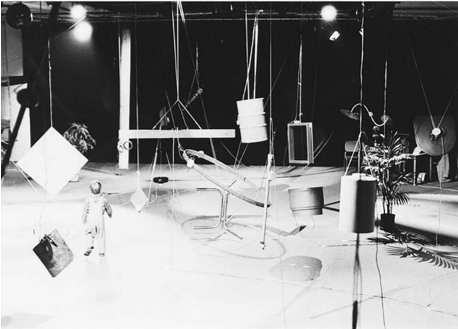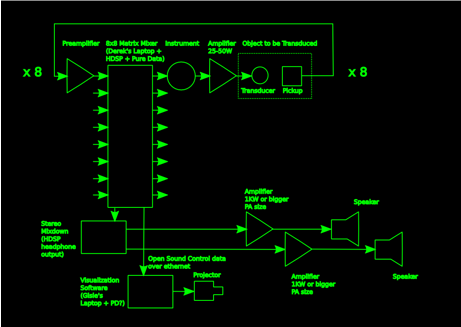Regnskog
REGNSKOG
Bergen Kjøtt October 11-17 2010
--
REGNSKOG: a Collaborative Workshop/Performance/Installation in the Spirit of David Tudor
INTRODUCTION: HANDS DIRTY ART
Over the past few years, a strong reaction against the sterile world of laptop sound and video has inspired a new interest in analog processes, or "hands dirty" art in the words of practitioner John Richards. With this renewed analog interest comes a fresh exploration of the pioneers of the electronic arts during the pre-digital era of the 1960s and 1970s. Artists and inventors such as Nam June Paik, Steina & Woody Vasulka, Don Buchla, Serge Tcherepnin, Dan Sandin and David Tudor all constructed their own unique instruments long before similar tools became commercially available or freely downloadable--and often through a long, rigorous process of self-education in electronics.
DAVID TUDOR'S RAINFOREST
David Tudor, in particular, has become the focus of intense interest (c.f. Leonardo Music Journal 14, 2004). His transformation from John Cage's concert pianist to an electronic performer and autodidact engineer in his own right is archetypal for the contemporary media artist, who also must oscillate between the creative and the learning processes. His work "Rainforest" also stands out as an exemplary model of the collaborative process within a technically defined, yet socially open system.
"Rainforest" used a series of transducers to play prerecorded and live sounds through various resonant metal objects suspended by wires in the performance space. It was also conceived as a workshop, involving different musicians and artists in a collaborative setting, each contributing their own sounds, ideas and energies to the performances, which often lasted four or five hours! A complex mixer system allowed the sounds coming from one resonant object to be directed through another, spawning chaotic generations of new sound patterns. The sounds played could be heard through loudspeakers as well as the objects themselves, however they could also be physically felt by touching the objects. Tudor was especially interested in two audiences: children and the blind.
REGNSKOG
"Regnskog" is conceived as a contemporary re-interpretation of "Rainforest" as a workshop, performance and public installation. In the spirit of Tudor's work, much of the equipment and materials will be built by the participants/performers themselves.
BACKGROUND READING
Bill Viola-David Tudor: The Delicate Art of Falling(Leonardo Music 14)
John Driscoll and Matt Rogalsky-David Tudor’s Rainforest: An Evolving Exploration of Resonance(Leonardo Music 14)
http://macumbista.net/wp-content/uploads/2010/09/tudor_rainforest.zip
PREVIOUS RAINFOREST IV'S
London 2009
Pictures:
http://www.flickr.com/photos/phil_julian/with/3690589728/
Videos:
http://vimeo.com/11912552 http://www.youtube.com/watch?v=2IeIY3Xw5yM http://www.youtube.com/watch?v=21zIUf7zYG8
Audio:
http://www.archive.org/details/RainforestIvPerformance --
PARTICIPANTS
Harald Fetveit, Oslo
Signe Lidèn, Bergen
Ryan Jordan, London
Derek Holzer, Berlin
Julien Ottavi, Nantes
John Hegre, Bergen
Jørgen Træen, Bergen
Gisle Frøysland, Bergen
Jørgen Knudsen, Bergen
LOCATION
Bergen Kjøtt is an old meat factory turned into artist space. It contains artist studios, music studios (Duper), rehearsal rooms, architects, designers and more. It's all kept raw and factory-like. Here's some images of the room where we'll be working:
SCHEDULE
October 11-15 workshop
October 15-16 open installation/performance sessions
FRIDAY OCT 15th
- - Opening hours: 18:00-23:00
- - Performance session: 20:00-23:00
SATURDAY OCT 16th
- - Opening hours: 14:00-23:00
- - Performance sessions: 14:00-18:00, 20:00-23:00
TECH OVERVIEW
Here is a graphical overview of the signal flow of Regnskog:
Full size: http://macumbista.net/wp-content/uploads/2010/09/regnskogsvg.png
Original Tudor Rainforest diagram:
Full size: http://macumbista.net/wp-content/uploads/2010/09/rainforest1.jpg
The Hub
The central "hub" of the installation will be an 8x8 matrix mixer, built in Pure Data using a Hammerfall HDSP soundcard as interface. This will allow the sound from any object to be sent to any of the players for processing. The status of the matrix mixer will also be sent via OSC to Gisle, who will visualize this (also in Pd/GEM?).
Per Channel Equipment
As shown in the diagram above, each channel will require one of the following things. There are 8 channels in total.
- Preamp: a simple, low power circuit to amplify the sound from the pickups to line level before entering the matrix mixer. (Derek can construct/order these)
- Instrument: that's where the players come in. Each of you should bring or construct some sort of instrument capable of taking the signal from the matrix mixer and processing or manipulating it in some way. Simple transformations could be filtering/equalizing. More complex processing is up to you!
- Amplifier (50W): this amp drivers the transducers. A power rating of 50W should cover most of the transducers used.
- Transducer: there are many kinds of transducers, see TECH NOTES below. It would be good to know what kind of transducers the participants can bring. Derek may order a set of matching transducers besides.
- Pickup: simple piezoelectric "contact mic" pickup most likely. There are many other kinds of pickups and participants are encouraged to bring and experiment with others. Derek will bring a bunch of piezos.
General Equipment
Besides these things, we will also require the following elements in the space:
- Stereo PA: a stereo mixdown of the matrix mixer will be available from the HDSP headphone output. So we will need a basic stereo PA. Keep in mind that this is mostly for a general room sound, and that visitors are encouraged to experience the sounds directly from the objects by touch and hearing. 1KiloWatt of power per channel is definitely overkill, it will depend on the space and how much rooom sound we want...
- Video projection system: the status of the matrix will be sent by OSC to Gisle's PD patch, which will visualize it and send it to the data projector. Other suggestions (from Gisle?) include: (hm. maybe not visualizing in the traditional sense. I might use the osc input, but was more thinking of finding some way of using video similar to the original Tudor ideas of specialized multichannel output.)
- - what can be found of old crt TVs
- - 1 Edirol V-4 and a couple of older mixers
- - a selection of wi-fi and wired cameras
Other considerations:
- Lighting: for each object/performer
- Suspension system: the objects will be suspended from the ceiling with metal cable, so we will need to figure out exactly how this can be done in the space
- Lots of cable!!!
TECH NOTES
Commercially Available Transducers
Vibro motor - http://www.seas.no/ Gisle may investigate getting some sponsorship from them
Tactile transducer comparison - http://www.baudline.com/erik/bass/tactile_report.html
Visaton Principles of exciter technology - http://www.visaton.de/downloads/pdf/visaton_exciter_principles.pdf
Visaton VS-EX60S-8 Loudspeaker exciter [25W average power/40W max power, 8 Ohm, 58x58x20, approx EUR 15 each @ 10 pieces] (http://www.visaton.de/en/industrie/koerperschall/ex60s_8.html) I just noticed these don't work well for magnetic material because of the internal magnet, however...[D]
Rolen Star Audio Transducers (full range but easy to blow) http://www.rolen-star.com/ We can borrow 5 or 6 of these from a friend in Copenhagen
SinusLive Bass Pumps (low frequencies only but very robust) http://www.amazon.co.uk/Sinus-Live-Bass-Pump-III/ Derek can bring 3-4 of these
DIY Transducers
Julien says: "a strong magnet + a copper wire loop type as speaker filter component part", we are hoping to get some actual part numbers from Julien to order so we can try this
Nice (but very complicated!) howto for making DIY transducers: http://www.vikash.info/audio/transducer_design/
For the really simple approach (stripped down speaker connected to a sofa!): http://lumenlab.com/forums/index.php?showtopic=17062
From MakeMagazine, part I: http://www.make-digital.com/make/vol16/?pg=124&pm=2&u1=friend#pg124
From MakeMagazine, part II: http://blog.makezine.com/archive/2009/08/interns_corner_chladni_plate_the_al.html
TECH NEEDS
What do we need?
- Equipment listed above
- Scrap metal (Piksel identifies good spots for scrap harvesting on beforehand)
- Car for picking up stuff (Piksel rents)
- Each participant flown in from the EU brings a bottle of some Spirituous from the Duty Free (you know who you are...)
- Local Bergen volunteer to do photo/video documentation (paid perhaps in above-mentioned "Spirituous"...)
notes added by Julien / serious tek need!!!!
-mixers / at least 12 input and minimum 4 output (mackie like) - I will need one, won't be able to bring mine (too big)
-amplifiers / this is a very important features, if we could have 50W amplifiers (not hifi) but preferably PA's one (feedback will easily destroyed them)
-lot of jack-jack / xlr-xlr / / speakers cable and spare cable (with headz 2 make)
-1 amplified speakers / PA (I still do think, and David Tudor was always in this case) have our own speakers (best: a mono or stereo PA system / or at least a strong pair of monitoring studio speakers -Yamaha like)
-light (PAR?) for sculpture and musicians
-theatre installation cable like + hooks, the kind of things which we will use to hang up the sculpture (very important)
-power extension
-tools to work out the sculpture (holes...) / gloves
-tables & chairs
What can you provide?
Don't be shy!!!! ;-)
- Harald:
- - piezos
- - laptop
- Signe:
- - laptop
- - pickups (piezo, coils)
- - 5 amps (customized for a kind of electromagnetic acoustic transducer-system)
- - magnets, copper wire
- Ryan:
- - laptop
- - 4channel mixer
- - cmos + 555 , if any use
- - caps + resistors
- Derek:
- - HDSP + laptop
- - piezo pickups
- - preamps
- - transducers
- Julien:
- - laptop/PC - apodio+PD+jackd
- - Echo Layla pcmcia 8x8 IO
- - 2 transducers
- - 1 bass pump
- - few piezos
- - preamps
- - analog feedback filter
- John:
- Jørgen:
- Gisle:
- - laptop/PC running PD+MøB
- - 8x16 matrix switcher for composite video controlled by PC
- - 1 Blaupunkt & Panasonic video mixers (good old stuff)
- - a selection of cheap wi-fi and wired cameras (composite)
- Piksel:
- 1 projectorjust got nicked in pikselhut breakin :((- - 1 6 chn audio mixer
- -
108 soldering sets (2 seems to be gone after breakin..) - - Drills
- - Electric saws
- - magnets, copper wire
- - speaker/microphone cable (shopped according to need at Clas Ohlsson)
PLANNING
Brainstorm area...


